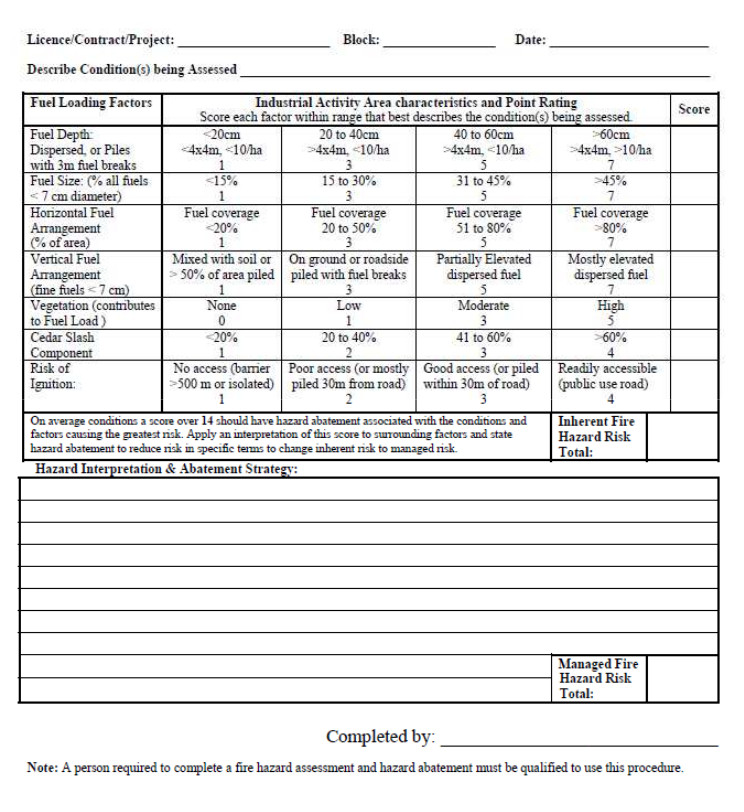Fire Hazard Assessment Procedures App E - September 23, 2016
Fire Hazard Assessment Procedure
Appendix E
This Assessment is from the BCTS Strait of Georgia Business Area EMS Public Web Site:
http://www.for.gov.bc.ca/bcts/areas/TSG_certification.html. It will be used on IR7 to assess the Fire
Hazard conditions and risk.

Guidance and Interpretation
Wild Fire Act Section 7 Legal Requirement
In prescribed circumstances and at prescribed intervals, a person carrying out an industrial activity or a prescribed activity on
forest land or grass land or within 1 km of forest land or grass land must conduct fire hazard assessments.
A person carrying out an industrial activity or a prescribed activity must abate within a prescribed period a fire hazard of which
the person is aware or ought reasonably to be aware.
Contractor’s should discuss in Pre-work who is responsible when this requirement is applicable.
Wild Fire Regulation Section 11 and 12
The hazard assessment must assess the fuel hazard, risk of a fire starting and spreading. The prescribed interval for assessment
and abatement is either:
Assessment every 3 months during the period of industrial activity when within an area of local government (municipal area or
regional fire protection district) and on completion of the activity if a shorter interval. Abatement of known hazard every 6
months following the assessment. Or,
Assessment every 6 months in all other areas and on completion of activity if a shorter interval. Abatement of known hazard
every 12 months following the assessment.
Abatement must reduce the fuel hazard without increasing the risk of a fire starting, fire behaviour or fire suppression.
A person may request an exemption to these requirements in the manner set out in Section 70 of the Wild Fire Act. If
an exemption is granted, any conditions or alternative requirement must be followed.
Qualified Persons
The assessments are to be conducted and abatement strategies prepared by individuals under one of two types of
qualification: A qualified person or a qualified professional.
A qualified person following a procedure prepared by a qualified professional. A qualified person is suggested to be a person
with considerable experience in completing fire hazard assessments and abatement strategies including fire control or prescribed
fire project experience and current S-100 firefighting course accreditation.
A procedure prepared by a qualified professional is either the one offered by Strait of Georgia BA for use on their projects or
any other procedure prepared by a qualified professional.
A qualified professional has the right of practice in BC under a recognized Professional Association and declares themselves
qualified in this practice. Need not follow any procedure. They may simply document in their professional opinion the fuel
hazard, risk of a fire starting and spreading and any required abatement if they know a fire hazard exists.
Assessment Procedure
The procedure allows 2 conditions to be assessed together most common on operations; dispersed fuel over a cut
block with piled fuel to establish plantable area or to achieve some other objective. Piles either have 3 meter fire
breaks being lower risk, or not and must be considered higher risk than dispersed fuel. If the conditions at the site of
the activities are too complex to reasonably assess together, multiple assessment should be done separating similar
from dissimilar conditions.
The fire hazard score of 14 is not a clear indication of a fire hazard or not. It is a default threshold for average
conditions where the assessor must put their minds too for determining if a fire hazard exists. The abatement
strategy must reduce the fire hazard so as to make the likelihood of a fire starting or spreading acceptable to the
assessor considering all factors. This can be one or a combination of reducing fuel loading, rearranging fuel,
removing ignition sources, creating fuel breaks and limiting access.
Fuel Loading Factors
In general terms each of the 7 factors scored should be interpreted as they approximate the actual conditions being
assessed. Using good judgement and awareness assess each factor, low risk being the lowest number and high risk
being the highest number. All factors must be scored to make the threshold of 14 of any significance. Other
considerations such as values at risk, likelihood of human or lightning fire starts, slope position, terrain, aspect,
adjacent fuel hazards, local prevailing winds and local fire history should all be used to shift a score higher or lower
to resolve uncertainty. And likewise to interpret if the overall score is over or under an acceptable threshold for the
specific area of activity to trigger abatement strategies.

Note: This guide is not an instructional tool. The assessor is assumed to be qualified to follow this
procedure and be able to interpret its intent. This procedure is under continuous improvement and the
most current dated version will be on the BCTS Strait of Georgia Business Area EMS Public Web Site:
http://www.for.gov.bc.ca/bcts/areas/TSG_certification.html
